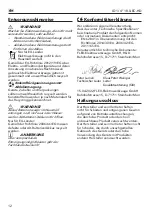
17
ID 1/4” 18.0-EC-HD
NOTE
The variety of wood density and metal
material may affect the final outcome. The
user should select appropriate mode based
on the application.
WARNING!
Do not change the working mode while the
tool is running.
Sudden change of torque
may cause the loss of control causing possible
injury or damage to the tool or workpiece.
NOTE
The LED indicator will turn off approximately
1min after the trigger switch is released.
NOTE
When the tool is next turned on, the working
mode will revert to the previous setting.
Switching on the power tool (see
figure I)
■
To switch the power tool on:
Press the trigger switch 3.
The variable-speed trigger switch delivers
higher speed with increased trigger pressure
and lower speed with decreased trigger
pressure.
In T1 and T2 modes pressing the trigger
switch will deliver the highest rotation
speed within current mode regardless of the
pressure exerted on the switch.
■
To switch the power tool off:
Release the trigger switch.
LED light (see figure J)
■
The LED light will automatically turn on
with a slight squeeze on the variable-
speed trigger switch before the tool starts
running and will turn off approximately 10
seconds after the variable speed trigger
switch is released.
■
The LED light will rapidly flash when
the tool and/or battery pack becomes
overloaded or too hot, and the internal
sensors will turn the tool off. Rest the tool
for a while or place the tool and battery
pack separately under air flow to cool
them.
■
The LED light will flash more slowly to
indicate that the battery is at low-battery
capacity. Recharge the battery pack.
■
If the LED fails to light up when you switch
on the tool, or it turns off suddenly during
your operation, it may be caused by the
internal communication error. Please
contact customer service or an authorized
service center for assistance.
Tighten and loosen screws, nuts
and bolts (see figure K & L)
Select the T1 or T2 mode as necessary, based
on your application. For more details see
related section: Mode Selection. For mode 1,
2, or 3: variable-speed control must be used
with caution for driving nuts and bolts using
socket-set attachments. The best technique
is to start slowly, increase speed as the nut or
bolt runs down, and then set the nut or bolt
snugly by slowing the tool to a stop. If this
procedure is not followed, the tool will have
a tendency to torque or twist in your hand
when the nut or bolt seats.
It is advisable to perform a trial run on a
scrap material to determine the best mode
selection.
■
Install a suitable bit.
■
Apply just enough pressure to keep the bit
engaged on the screw or nut.
■
For mode 1, 2, or 3, apply minimal pressure
to the variable-speed trigger switch
initially. Increase the speed only when full
control can be maintained.
NOTICE:
■
Always use the correct type and size of bit
for your application.
■
When turning in a screw at/near the
crosscut end or an edge of wood, pre-drill
a hole in order to avoid cracking of the
wood.
■
When screw driving in hard wood, one
should pre-drill a pilot hole.
WARNING!
Do not over-tighten, as the force of the impact
driver can break the fastener. Keep the impact
driver at a right angle to the fastener to avoid
damaging the fastener head.
Содержание 520756
Страница 1: ...ID 1 4 18 0 EC HD ID 1 4 18 0 EC HD IMPACT DRIVER ...
Страница 3: ...7 1 2 3 5 4 6 8 9 10 B 1 2 C A ...
Страница 4: ...D E F H G I ...
Страница 5: ...L K J ...
Страница 179: ......
















































